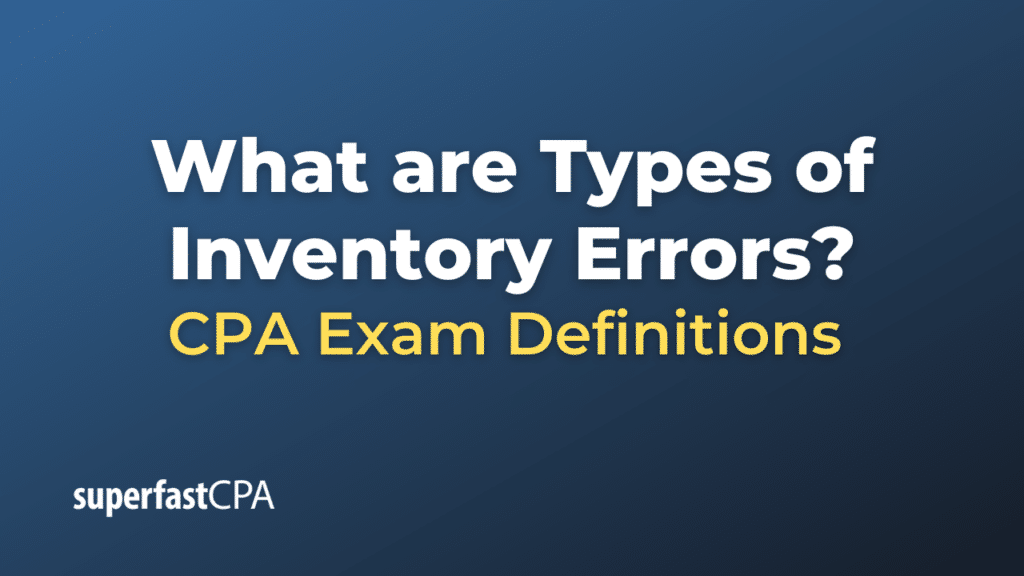Types of Inventory Errors
Inventory errors can have significant impacts on the financial statements of a business, affecting the cost of goods sold, gross profit, and ending inventory balances. Understanding these errors is crucial for both internal management and external stakeholders. Here are the primary types of inventory errors:
- Beginning Inventory Errors:
- If the beginning inventory is incorrect, it will affect the cost of goods sold and the gross profit but will not impact the ending inventory of the current period. However, it will affect the beginning inventory of the next period.
- Ending Inventory Errors:
- An error in the ending inventory will directly affect the cost of goods sold and gross profit for the current period, and it will also influence the beginning inventory for the subsequent period.
- Understatement of Purchases:
- If purchases during a period are understated, it will reduce the total available goods for sale and, consequently, either the ending inventory, cost of goods sold, or both.
- Overstatement of Purchases:
- Overstating purchases will increase the total available goods for sale, affecting the ending inventory, cost of goods sold, or both.
- Failure to Record Purchases or Sales:
- Not recording purchases will result in an understatement of inventory and possibly an understatement of accounts payable.
- Failing to record sales may result in an overstatement of inventory and an understatement of revenue.
- Errors in Physical Count:
- Mistakes while physically counting inventory (e.g., miscounting, mislabeling) can lead to discrepancies between the actual inventory and the recorded numbers.
- Errors in Valuation:
- Incorrectly applying an inventory valuation method (e.g., FIFO, LIFO, weighted-average) or inconsistent application of the chosen method.
- Using inappropriate costs (e.g., including selling expenses in inventory costs).
- Theft or Loss Not Accounted For:
- If inventory is stolen or lost and not accounted for, the physical inventory will be less than the recorded inventory.
- Errors in Allocating Overhead:
- Incorrectly allocating overhead costs to inventory can lead to its misvaluation.
- Recording Goods in Transit Incorrectly:
- Failing to account for purchased goods in transit at the end of a period or mistakenly recording inventory that has been sold and is in transit to customers.
Remember, the effects of these errors can ripple through various financial statements. For instance, an understated inventory can result in an overstated cost of goods sold, which will reduce reported profits. It can also influence metrics like inventory turnover ratios and gross profit margins, among others. Regular reconciliation, stringent internal controls, and periodic inventory counts can help in preventing or identifying these errors.
Example of Types of Inventory Errors
Let’s go through a few of the mentioned inventory errors with examples to understand them better:
- Beginning Inventory Errors:
- Example: At the start of the year, ABC Company mistakenly recorded its beginning inventory as $5,000 instead of the correct $7,000. This $2,000 understatement will result in a higher cost of goods sold and a lower gross profit for the year. However, the ending inventory will not be impacted by this error for the current year.
- Ending Inventory Errors:
- Example: At the end of the year, XYZ Company miscounted its inventory, recording it as $8,000 instead of the actual $10,000. This $2,000 understatement will lead to a higher cost of goods sold for the year and a lower gross profit.
- Understatement of Purchases:
- Example: DEF Company recorded purchases of $30,000 during the year when, in reality, they made purchases worth $35,000. This $5,000 understatement will lead to a lower total available inventory for sale, affecting the ending inventory and cost of goods sold.
- Errors in Physical Count:
- Example: When performing a physical count, GHI Company’s employee miscounted a batch of items, missing out on 100 units. If each unit costs $10, this would result in an understatement of inventory by $1,000.
- Errors in Valuation:
- Example: JKL Company applies the FIFO (First-In-First-Out) method for its inventory. However, due to a system glitch, several batches of inventory were mistakenly valued using the LIFO (Last-In-First-Out) method. This could result in a significant misstatement of the inventory’s value, especially if there were notable price fluctuations during the year.
- Recording Goods in Transit Incorrectly:
- Example: MNO Company purchased goods worth $4,000, which were in transit at the end of the year. They mistakenly didn’t account for these goods as part of their inventory. This results in an understatement of both inventory and accounts payable by $4,000.
Understanding and rectifying these errors is crucial for accurate financial reporting. It’s worth noting that errors in one accounting period can have a carryover effect into the next period, especially with inventory errors. As a result, it’s essential to catch and correct these errors as soon as possible.













